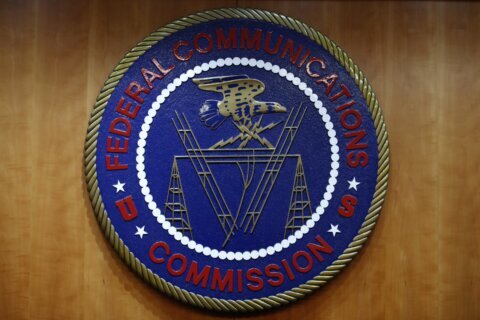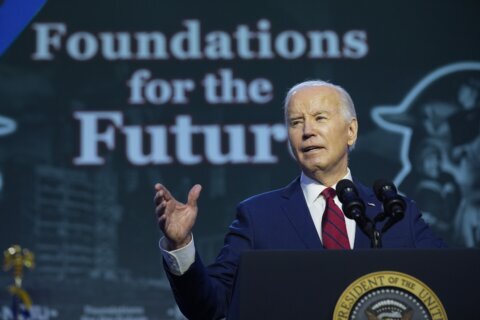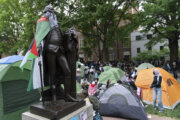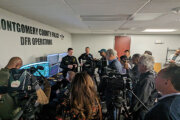WASHINGTON (AP) — The nation’s employers stepped up their hiring in May, adding a robust 339,000 jobs, well above expectations and evidence of enduring strength in an economy that the Federal Reserve is desperately trying to cool.
Friday’s report from the government reflected the job market’s resilience after more than a year of aggressive interest rate increases by the Fed. Many industries, from construction to restaurants to health care, are still adding jobs to keep up with consumer demand and restore their workforces to pre-pandemic levels.
Overall, the report painted a mostly encouraging picture of the job market. Yet there were some mixed messages in the May figures. Notably, the unemployment rate rose to 3.7%, from a five-decade low of 3.4% in April. It’s the highest unemployment rate since October. (The government compiles the unemployment data using a different survey than the one used to calculate job gains, and the two surveys sometimes conflict.)
IS THE LABOR MARKET AS STRONG AS THE GAIN OF 339,000 JOBS SUGGESTS?
Probably not. In May, employers added the most jobs since January. So the overall picture is an encouraging one. Yet there are signs that hiring is cooling from the super-heated levels of the past two years.
For one thing, the length of the average work week declined, to 34.3 hours from 34.4 in April. That is a seemingly small drop, but economists said it’s equivalent to cutting several hundred thousand jobs. It means that, on average, weekly paychecks will be slightly smaller. The average work week is down from 34.6 hours a year ago.
Hourly wage growth also dipped in May, evidence that many businesses feel less pressure to dangle higher pay to find and keep workers. Average hourly pay increased 4.3% from a year earlier. That’s down from gangbusters gains of nearly 6% a year ago.
And the rise in the unemployment rate partly reflected higher layoffs. This suggested that not everyone who lost jobs in recent high-profile layoffs by banks, tech firms and media companies has found new work.
IS THE ECONOMY HEADED FOR A RECESSION?
Not likely anytime soon. The strong, steady job growth of the past several months shows that the economy remains in solid shape despite the Fed’s interest rate hikes, which have made borrowing much costlier for businesses and consumers. A recession, if one occurs, is likely further away than many economists had previously thought.
“As long as the economy continues to produce above 200,000 jobs per month, this economy simply is not going to slip into recession,” said Joe Brusuelas, chief economist at consulting firm RSM.
More hiring translates into more Americans earning paychecks, a trend that suggests that consumer spending — the principal driver of U.S. economic growth — will keep growing.
DOES THAT MEAN THE ECONOMY IS IN THE CLEAR?
Not necessarily. Some cracks in the economy’s foundations have emerged. Home sales have tumbled. A measure of factory activity showed that manufacturing has contracted for seven straight months.
And consumers are showing signs of straining to keep up with higher prices. The proportion of Americans who are struggling to stay current on their credit card and auto loan debt rose in the first three months of this year, according to the Federal Reserve Bank of New York.
Sales at several retail companies, including discount chain Dollar General and department store Macy’s, have weakened. That indicates that lower-income consumers, in particular, are feeling squeezed by high inflation.
And the threat of further interest rate hikes by the Fed, in its continuing drive to fight inflation, always looms. The Fed’s rate increases have elevated the costs of mortgages, auto loans, credit card use and business borrowing.
The Fed has projected that its rate hikes will weaken the economy and raise unemployment, as well as lower inflation. Still, Chair Jerome Powell has held out hope that the central bank can significantly slow price growth without causing a deep recession.
“The continued strength in employment pushes back the start of a prospective recession but does not eliminate that likelihood,” said Kathy Bostjancic, chief economist at Nationwide. “If the economy remains too hot to meaningfully slow inflation, the Fed will simply raise rates higher, still a path towards a downturn.”
WHAT DOES ALL THIS MEAN FOR THE FED’S APPROACH TO INTEREST RATES?
Top Fed officials signaled earlier this week that they plan to forgo a rate increase at their June 13-14 meeting. This would allow them time to assess how their previous rate hikes have affected the inflation pressures underlying the economy.
The Fed has increased its key rate by a substantial 5 percentage points since March 2022, to about 5.1%, the highest level in 16 years. Higher rates typically take time to affect job growth and inflation.
Some Fed officials might be unnerved by the burst of hiring in May and push for another rate hike this month. But many economists say last month’s rise in unemployment and slight decline in wage growth will likely be sufficient signs of a slowdown for the Fed to leave rates alone.
WHY DID THE UNEMPLOYMENT RATE RISE?
The government’s jobs report is derived from two separate surveys that are conducted each month. One survey covers businesses, the other households. The survey of businesses is used to calculate the job gain (or loss). The household survey, which asks people if they’ve done work for pay in the past month, determines the unemployment rate.
In May, the surveys diverged: Households reported an actual loss of jobs, while the survey of businesses found a sharp gain. Though the two surveys can diverge as they did for May, over time they generally produce similar results. The survey of businesses is larger and is generally regarded as more reliable, though the household survey often does a better job of capturing turning points in the economy.
One key reason for the divergence is that, according to the household survey, the number of self-employed people fell by 369,000 from April to May. Self-employed workers are counted in the survey of households but not in the survey of businesses.
Drew Matus, chief economist at MetLife Investment Management, cautioned that the higher unemployment rate for May could signal weakness ahead. It suggests that companies are becoming more cautious about hiring.
Joblessness rose last month for teenagers, the disabled and people with less education, Matus noted. That was a sign that companies were cutting workers with fewer skills and less experience, a move that often precedes recessions.
“Before it was a rising tide lifts all boats, and now it seems like the boats have gotten smaller and firms are deciding who gets to sit in them,” Matus said.
WHO IS DOING THE HIRING?
The job gains in May were widespread across the economy. Companies in construction, shipping and warehousing, restaurants and hotels, government, health care and in such professions as engineering and architecture all added workers.
Many of those sectors have been struggling to restore their staffing to pre-pandemic levels. Restaurants, for example, are seeing strong demand yet still have fewer workers overall than they did before the pandemic.
One new worker, Mikala Slotnick, was hired as a barista last week by Red Bay Coffee and by Wednesday was working in their Berkeley, California, location. Slotnick, 21, has previously worked at large coffee chains but preferred Red Bay because it focuses on working directly with coffee growers overseas.
“It seems like they care more about what they’re producing, versus the money,” she said. “I think that’s just way better.”
____
AP video journalist Haven Daley in San Francisco contributed to this report.
Copyright © 2024 The Associated Press. All rights reserved. This material may not be published, broadcast, written or redistributed.







